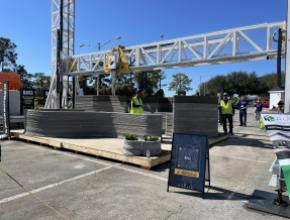ORONO, Maine 𑁋 The University of Maine said it is home to the world’s largest polymer 3D printer in its Advanced Structures and Composites Center (ASCC).
Researchers at the center are now working to use the printer to build affordable, sustainable housing using wood residuals such as sawdust and construction debris to create wood flour which is bound into pellets by biopolymers for use in the 3D printing process.
The UMaine team, working in partnership with researchers at the U.S. Department of Energy’s Oak Ridge National Laboratory, is developing a prototype weatherproof and insect-proof single housing unit, being built in collaboration with the Maine State Housing Authority (MaineHousing) at the ASCC’s “Factory of the Future,” according to Composites Manufacturing magazine.
The prototype should be ready for outdoor testing by the end of 2022. Homes will be built in sections, including walls, floors, and roofs. When production scales up, it may be possible to print a 600-square-foot house in as little as three days. The process, materials, and technology could also be used to build apartment building.
Founding executive director of the ASCC, Habib Dagher, that said the center aims to “produce the workforce of the future.” Plans call for the “Factory of the Future” at the ASCC, which includes robotics and artificial intelligence technology to automate processes, to be up and running by 2025 and will include a training facility for students and industry professionals to learn how to operate, design, and maintain the machines and software involved in automated construction.
“We need to … not only develop the technology, but train the workforce that’s going to be able to operate this equipment,” Dr. Dagher said. “What we’re trying to do is develop fundamental solutions to the problems.”
University qualifies two CLT grades
The University of Maine’s ASCC qualified two new grades of Cross-Laminated Timber (CLT) using Maine-sourced lumber. That is, Maine lumber can now be used in CLT building construction, for buildings as high as 10 stories or more.
“The Advanced Structures and Composites Center is at the forefront of leveraging Maine’s abundant natural resources, like wood, to drive sustainable economic development opportunities through research, development, commercialization and workforce training,” said Habib Dagher, executive director of the ASCC. “Working hand in hand with our partners in industry, our goal is to develop the materials and technologies to drive future value streams for the Maine forest products industry and train our next-generation manufacturing workforce.”
This classification comes as the University of Maine-led FOR/Maine Coalition was selected as a finalist in the U.S. Economic Development Administration’s (EDA) $1 billion Build Back Better Regional Challenge. The proposal aims to accelerate the Northern Forest Bioeconomy through innovation, commercialization, and workforce and community redevelopment. The plan expands on the Forest Opportunity Roadmap (FOR/Maine) vision and strategic plan for diversifying the state’s wood products businesses, attracting new capital investments, and developing greater economic prosperity for Maine communities impacted by recent mill closures.
“The future of construction is CLT and mass timber,” said Benjamin Herzog, wood technologist at ASCC. “Because timber is a renewable resource and wood serves as a carbon sink, its use is clearly the most environmentally friendly option. Mass timber construction is also more efficient due to reduced construction time and labor needed compared to other construction methods.”
“This certification illustrates the benefits of industry, the University of Maine, and federal agencies collaborating to drive innovation and to strengthen and diversify Maine’s forest-based economy,” said Stephen Shaler, professor of sustainable materials and technology at UMaine, interim chair of the FOR/Maine Executive Committee and principal investigator of the project.
The new CLT grades were manufactured using both machine stress rated (MSR) and visual grades of Spruce-Pine-Fir (South) (SPF-S) lumber from Maine. Lumber was supplied by Maibec Lumber Co. in Masardis, Maine, and Pleasant River Lumber Co. in Moose River, Maine, both of which are certified by the Northeastern Lumber Manufacturers Association (NELMA). The lumber was shipped to SmartLam, LLC in Columbia Falls, Montant for CLT manufacturing before returning to ASCC for testing.
Researchers analyzed the test results, comparing them to engineering requirements, and concluded that both grades met building standards. One grade has some of the highest published properties of any CLT grade currently listed in the North American Performance Standard for CLT, ANSI/APA PRG 320. The other grade proved comparable to CLT grades manufactured with Douglas fir, a species known for its high stiffness and strength.
“Although there are not currently any CLT manufacturers in Maine, it’s our hope that these test results demonstrate that Maine’s forest resource can sustainably provide high-quality lumber needed for this burgeoning industry,” said Russell Edgar, wood composites manager at ASCC.
ASCC is planning a state-of-the-art 90,000-square-foot expansion, nearly doubling its current footprint, for a Green Engineering and Materials Laboratory. The GEM Factory of the Future will transform manufacturing with AI-enabled arrays of 3D printers and sensors that will manufacture and test new products from advanced bio-based and forest-based materials. The GEM Factory of the Future will be a mass timber structure, constructed with a combination of glulam and CLT.






Have something to say? Share your thoughts with us in the comments below.